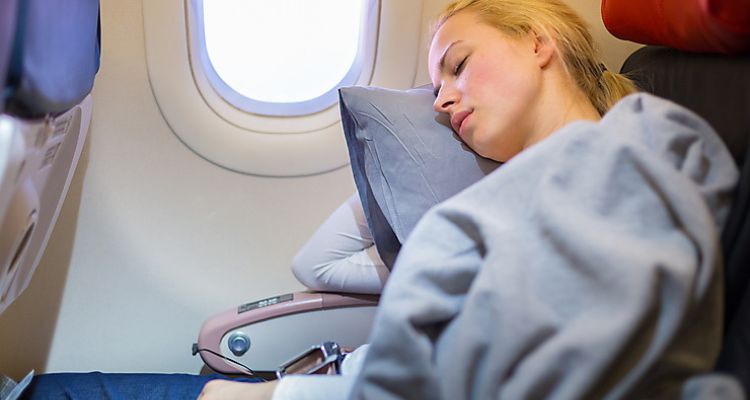Taking a plane trip can be stressful when you are not used to it. You may start to shiver during nighttime flights as it tends to get colder on overnight flights. Well, there are a lot of rules and regulations you need to follow during flights.
You should know which things you can carry or what you have to leave back and what can cost you extra to carry before boarding a plane since most airlines do not provide blankets, especially during domestic flights. At the same time, a limited stock is available on international flights. Therefore, the TSA allows you to bring your blanket in a handbag, carry bag, or on your lap.
So, if necessary, it’s better to carry a blanket for yourself or your child rather than relying on the airline’s mercy.
How Do Airplane Companies Categorize Blankets?
It will take a lot of room if you carry a blanket in your main carry bag or handbag. Since every inch matters when traveling, you must be careful about what you should bring and what to leave behind.

Airlines keep limiting their luggage limits, and many of us face the issue of extra weight at the last minute of checking in. Even though airlines allow you to carry small personal belongings like Purse, Backpacks, and Briefcase, blankets can easily fall short due to the weight limit.
So, if you even encounter such a similar situation, you can easily carry a blanket on your lap instead of stuffing it inside your small carry bag.
TSA and most airlines have mentioned on their websites that you can bring blankets, books, hats, and jackets on a plane. But we still recommend checking their websites for updated policies before packing to avoid any possible last-minute headache.
How to Choose a Blanket for Long Haul Flight?
Even though you can carry a blanket freely on the plane, still you need to be a bit careful about some limitations and features of that blanket.
Blanket Weight and Size
There is no limit set by TSA or any airline authority regarding the weight and size of the blanket. You can carry any size and weight blanket, but that means something other than literally any of them.
Pick a lightweight blanket that can easily cover your whole body to carry around on your lap. Since you may already have enough main luggage or hand-carry bag weight to carry around, it would make sense to carry a light-weighted blanket. You can easily hold and move around with it rather than create a burden for yourself.
Filling Material
Try carrying a blanket made using natural fibers, preferably 100% pure and safe wool and cotton. They will insulate heat more effectively than synthetic fibers to give comfortable sleep. Synthetic fibers cause heat and body sweating during sleep so try avoiding them. Try bringing a colorful blanket to avoid forgetting it on the plane.
Ease of Care
Bring a blanket that is easy to maintain and care for on the plane. If you bring a rough blanket, heavy or a large-sized blanket, it will be difficult for you and the airplane management to take care of. Therefore, always get a light-weighted and normal-sized blanket to provide ease to you instead of being a burden.
Cost
Avoid bringing a costly blanket on a flight, as you may need to remember it inside the plane once you leave. Airlines nowadays have become more competitive and try to charge as much as possible for extra essentials.
It even includes blankets though they don’t restrict carrying one in the plane. However, they will try to charge for it, so you need to be certain whether there is a need to have one.
Why Should You Bring A Blanket on An Airplane?
There could be many reasons forcing you to carry your blanket on an airplane. However, you may wonder if flights provide blankets, and I should not take one. But those were the good old days and not anymore, as this doesn’t happen now with most airlines, especially for domestic flights.
They sometimes charge you for bringing your blanket, let alone providing one from their side. You may feel more comfortable and fall asleep more quickly in your blanket than those publicly used freebies.
We recommend checking the airline’s policy and supply website page to check what they will provide on the flight. If there are additional charges, you may have to bear them from your end to avoid the last-minute hustling. Some policies or rules may even surprise you more than you can imagine.
Some Airlines Do Not Provide Blankets
Yes, all airlines have set their own rules and policies, and providing a blanket is nowhere found in them. Most airlines do not provide blankets, especially for domestic flight passengers. However, some do offer it on international flights, but since they have limited numbers onboard, they cater to only some people’s needs.
Another reason could be that most customers complain about the quality of the blankets provided. They find them unclean and not the right size, and they either avoid using them or complain about them.
Instead of providing the blankets from their end, most airlines now allow the customers to bring their own. They do not charge for that but have set certain criteria and specifications.
Checking them on their website’s policy or items supplied section can be helpful instead of facing an issue at the airport as a restriction dispute. Besides, it’s better to bring your blanket when you can easily carry it around your lap to avoid any problems. Just ensure they are light-weighted with the right length to fit the whole body.
Avoid Extra Charge
At first, most airlines do not provide blankets, but some offer one charge. Since airlines do business by providing the customer with the cheapest services considering the market competition, they have to opt for such policies to cut their expense to gain maximum profit. If they have to upcharge for you something extra, they might as well even do that.
Similarly, customers look for ways to cut their expenses when traveling. Since airlines do not provide free blankets and charge you for them, it’s better to bring one. As TSA and many airlines allow for that, you should carry along one but only the right weight and size blanket for your convenience.

Hygiene/Cleanliness
Maintaining personal hygiene is important, including not sharing things personally on public levels. A blanket accounts for an individual bedding item that most of us dislike sharing unless necessary.
Although some airlines provide limited numbers of blankets to passengers, most probably, they don’t use new blankets each time. This would increase their cost and ultimately can make them suffer. Therefore, they reuse the same blankets after washing them instead of offering new ones.
Even though airlines claim their blankets are nice and tidy as the flight attendants wash them frequently after every trip. But this might not necessarily be true as they sometimes need more time between flights to rush to the airport laundry to clean them.
So, instead of relying on airlines, it’s better to arrange your blanket. Using public blankets might not be a good idea, especially nowadays, as it can lead to certain health issues.
Blanket Connoisseur
Suppose you have a personal taste in blankets and only like to use your own for certain reasons. It’s better to bring your own instead of sharing those publicly used pieces.
Since the qualities of blankets most airlines offer are not up to mark, you should not look towards them in this case. You will feel more comfortable and fall asleep more quickly in your blanket compared to the one airline provides.
Another important issue you may face is the thickness of the length and width of that blanket. The blankets airlines provide are usually thinner with a short height; therefore, you may need to fit better in them and feel cold due to unsatisfactory quality. Your blanket will give you extra home-like comfort that you will surely not get in those airline blankets.
What Type Of Blanket Should You Bring?
You might be wondering at this point, “Why did I never bring my blanket on a plane?” even though it was the most comfortable and cheapest option I had available. It is probably due to the confusion about which blanket I should carry on a plane that I can easily travel with.
You have made all the necessary packing and have taken all measures, but now it all comes down to choosing the main thing: which blanket type to carry on the plane? Check how well you will go along with the below types.
Fluffy Blankets
We all love fluffy blankets and curl up in them on a couch. But there might be better blankets to carry around at airports or even on planes. Yes, they may feel comfortable, cozy, and luxurious while curling up at home during winter movie times.
They are difficult to fit in carry-on bags and a nuisance to lap around your arm. Therefore, it might be best to leave them home unless you have experience carrying them on flights.
Weighted Blankets
For some people, their weighted blankets are the most favorite blankets to sleep with at night (check 6 amazing bamboo weighted blankets). They offer the perfect pressure amount needed for a comfortable and relaxed sleep. Therefore, it is ideal for them to carry it on airplanes.
But before you decide to bring one along, you must think practically about them and how beneficial they can be. Holding them either in your arms or inside a carry-on bag can take more effort than their actual worth. If the weighted blanket has a weight limit between 15-25 pounds, carrying or lugging them around at airports can be frustrating.
Another bear in mind is that the blanket can get pretty messy by the time you reach your destination unless it has a removable protector cover. This means that to fulfill the wish of carrying your weighted blanket on the flight, you are taking all the germs and bacteria to your destination.
This can further put you and others at risk where you are headed. It might not be as helpful or fun to carry them on a plane as it may appear.
Can I use an airline blanket as a lap child’s car seat cover?
No, airline blankets should not be used as makeshift car seat covers. Lap child car seat covers are designed to securely fasten to the seat and withstand crash forces. Improperly secured children are at risk of injury. Only use car seat accessories recommended by the manufacturer.
What’s the best way to fold a blanket for airplane travel?
Rolling tightly is an effective way to fold a blanket for air travel. First lay the blanket flat and smooth out any wrinkles. Tightly roll the blanket from top to bottom or side to side. Secure with a strap or ribbons. This creates a compact bundle that can easily fit in a bag or on your lap.
Conclusion
You can bring blankets on the plane without restrictions, but ensure you carry the right size and weight. Otherwise, it can become inconvenient instead of comfort and relaxation. You can take them in your hand or arm lap for easy use in the plane as long as they fit easily under the passenger seat.
You can visit the TSA or airlines website page about rules and policies regarding the allowance of items you can carry inside the plane. In the end, avoid the airline blankets as they might need to be cleaner and more hygienic.
References
https://www.tsa.gov/travel/security-screening/whatcanibring/items/blankets
https://www.aa.com/i18n/travel-info/baggage/restricted-items.jsp
Bring a blanket on a plane FAQs
Does A Blanket Count As A Personal Item?
Regarding blankets, you don’t need to worry as they don’t count as personal items or carry-on. Most airlines allow them to carry them on a plane in your arms laps; therefore, there is no need to stuff them in your full suitcase.
Does The Blanket Have To Fit In Your Hand Luggage?
Not necessarily; you can carry them in the lap of your arms or hands rather than stuffing them in hand luggage. Most airlines allow them to carry onto the plane without any additional cost.
Are You Allowed To Knit A Blanket On A Plane?
Just pretend to look polite, relaxed, and friendly, and all will be fine. Most safety offers allow knitting on airplanes and do not stop unless they sense something to disallow it.
Do Airplanes Provide Blankets?
Most airlines do not provide blankets as it is costly for them to do so. Especially when it comes to domestic flights, however, they have some available for international flights, which can be risky to use.

